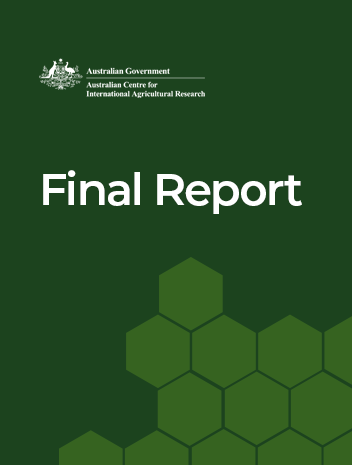- HomeHome
-
About ACIAR
- Our work
- Our people
-
Corporate information
- ACIAR Audit Committee
- Commission for International Agricultural Research
- Policy Advisory Council
- Agency reviews
- Executive remuneration disclosure
- Freedom of information (FOI)
- Gifts and benefits register
- Information publication scheme
- List of new agency files
- Contracts
- Legal services expenditure
- Privacy impact assessment register
- Commonwealth Child Safe Framework
- Benefits to Australia
- Careers
- 40 years of ACIAR
-
What we do
- Programs
- Cross-cutting areas
- Resources
- Where we work
-
Funding
- Research projects
- Fellowships
-
Scholarships
- John Allwright FellowshipScholarships to study in Australia for ACIAR partner country scientists to have Australian postgraduate qualifications
- ACIAR Pacific Agriculture Scholarships and Support and Climate Resilience Program
- Alumni Research Support Facility
- Publications
- News and Outreach
Project final report
Technical support for pearl culture in Tanzania - final report
Date released
02 October 2019
ISBN
978-1-925747-82-9
Publication Code
FIS/2011/069
Overview
This project aimed to assess whether culture methods developed for black-lip pearl oysters in the Pacific could be used in Tanzania, to establish methods for supplying pearl oyster juveniles to help develop pearl culture, and to develop baseline information that could help develop community pearl culture in east Africa.
Coastal mariculture could improve living standards in Tanzanian coastal communities. Pilot-scale research at Zanzibar and Mafia Island has shown that pearl culture can generate income. Pearl culture is a relatively benign form of aquaculture and compatible with marine resource conservation. Although the results of the pilot activities are promising, technical and strategic issues need to be addressed to maintain current momentum and to develop sustainable pearl culture.
Most oysters used for producing pearls were adults collected in the wild. Collecting adult oysters is unsustainable as a basis for development, and a reliable spat collection program must be established. The project also investigated hatchery production from facilities as a supply of oysters for culture. Assessing and adapting culture methods developed in the Pacific to Tanzanian conditionswas also necessary for development.
The research benefitted Tanzanian coastal communities, for which pearl culture generates income; this is compatible with national fisheries/development policy and marine resource conservation efforts. The Food and Agriculture Organization of the United Nations and the World Wildlife Fund have recognised that this concept has considerable regional potential in east Africa.



